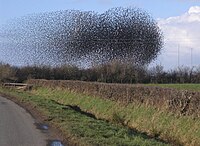
Photo from wikipedia
Chemically active particles suspended in a liquid solution can achieve self-motility by locally changing the chemical composition of the solution via catalytic reactions at their surfaces. They operate intrinsically out… Click to show full abstract
Chemically active particles suspended in a liquid solution can achieve self-motility by locally changing the chemical composition of the solution via catalytic reactions at their surfaces. They operate intrinsically out of equilibrium, continuously extracting free energy from the environment to power the dissipative self-motility. The effective interactions involving active particles are, in general, nonreciprocal and anisotropic, even if the particles have simple shapes (e.g., Janus spheres). Accordingly, for chemically active particles a very rich behavior of collective motion and self-assembly may be expected to emerge, including phenomena such as microphase separation in the form of kinetically stable, finite-sized aggregates. Here, I succinctly review a number of recent experimental studies that demonstrate the self-assembly of structures, involving chemically active Janus particles, which exhibit various patterns of motion. These examples illustrate concepts such as “motors made out of motors” (as suggestively named by Fischer [Fischer, P. Nat. Phys. 2018, 14, 1072]). The dynamics of assembly and structure formation observed in these systems can provide benchmark, in-depth testing of the current understanding of motion and effective interactions produced by chemical activity. Finally, one notes that these significant achievements are likely just the beginning of the field. Recently reported particles endowed with time-dependent chemical activity or switchable reaction mechanisms open the way for exciting developments, such as periodic reshaping of self-assembled structures based on man-made internal clocks.
Journal Title: Langmuir
Year Published: 2020
Link to full text (if available)
Share on Social Media: Sign Up to like & get
recommendations!